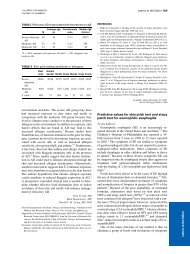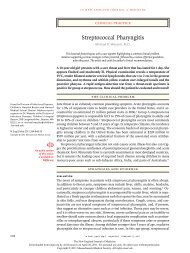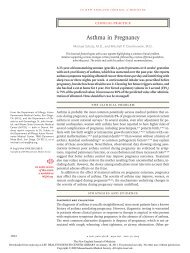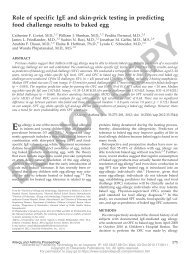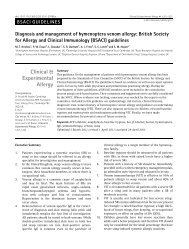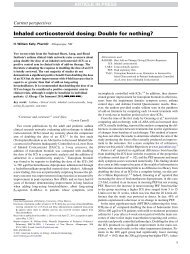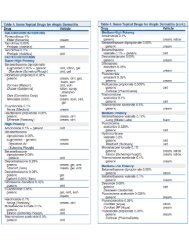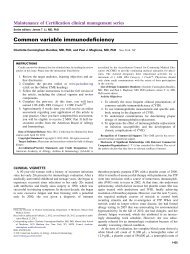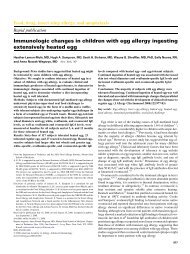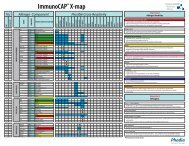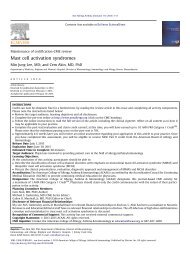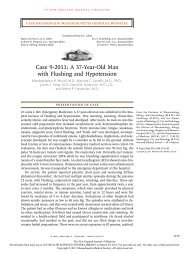Oral allergy syndrome: a clinical, diagnostic, and ... - AInotes
Oral allergy syndrome: a clinical, diagnostic, and ... - AInotes
Oral allergy syndrome: a clinical, diagnostic, and ... - AInotes
You also want an ePaper? Increase the reach of your titles
YUMPU automatically turns print PDFs into web optimized ePapers that Google loves.
physiology, available <strong>and</strong> investigational <strong>diagnostic</strong> testing,<br />
<strong>and</strong> evidence-based treatment options were selected.<br />
OAS has been a challenging diagnosis since the first published<br />
article in 1942 in which Tuft <strong>and</strong> Blumstein 1 discussed<br />
<strong>clinical</strong> observations of 4 adult patients who presented with<br />
itching of the soft palate <strong>and</strong> swelling of mucous membranes<br />
after eating various raw fruits. All patients reported a <strong>clinical</strong><br />
history of “hay fever” <strong>and</strong> indicated that their oral symptoms<br />
had a greater incidence during the summer months when<br />
seasonal allergies were worse. In addition, these patients<br />
reported that cooked, canned, <strong>and</strong> preserved forms did not<br />
cause symptoms. Tuft <strong>and</strong> Blumstein recognized this as a<br />
unique phase of food <strong>allergy</strong> in 1936 but had difficulty<br />
establishing its immunologic correlation. This connection<br />
came 6 years later with their inventive use of freshly extracted<br />
fruit juices in skin prick testing (SPT), which yielded<br />
positive reactions. These findings were eventually published.<br />
Interestingly, this article’s commentary revealed the publication<br />
to be more remarkable for a positive SPT result using<br />
fresh fruit extract in the setting of a previously negative test<br />
result <strong>and</strong> not for the first case presentation of OAS.<br />
Today OAS is recognized as a worldwide problem <strong>and</strong><br />
may represent the most common food <strong>allergy</strong> in adults. This<br />
speculation is largely because of its relationship with allergic<br />
rhinitis, which affects 10% to 30% of adults <strong>and</strong> up to 40% of<br />
children. 2 However, a true prevalence of OAS has yet to be<br />
determined. Early investigations described OAS prevalence<br />
based on specific fruits involved <strong>and</strong> their correlation with<br />
aeroallergens, such as the 1970 survey by Anderson et al 3 that<br />
asked 2,067 patients about symptomatic oral pruritus to either<br />
generalized or specific fruits, namely, melon <strong>and</strong> banana.<br />
Their results showed 4.3% of all patients interviewed <strong>and</strong><br />
6.2% of those with pollinosis described OAS symptoms. All<br />
these patients also demonstrated <strong>clinical</strong> <strong>and</strong> SPT reactivity to<br />
ragweed. A more comprehensive study was performed in<br />
1982 by Eriksson et al, 4 who questioned 600 adult <strong>and</strong> pediatric<br />
patients with documented allergic rhinitis (positive SPT<br />
or radioallergosorbent test [RAST] test results) regarding<br />
their tolerance of various foods. The results of this study<br />
found oral <strong>allergy</strong> symptoms in 70% of birch allergic individuals<br />
but only 20% of patients allergic to grass <strong>and</strong> mugwort.<br />
These studies remain today’s foundation for estimating<br />
OAS prevalence. However, allergists answering the 2003<br />
survey by Ma et al 5 on their management of OAS estimated<br />
the <strong>syndrome</strong>’s prevalence to be 5% in children <strong>and</strong> 8% in<br />
adult patients with nonspecific pollen allergies. In their discussion,<br />
the authors cited both physician underdiagnosis <strong>and</strong><br />
patient underreporting to explain their lower prevalence compared<br />
with earlier research. 5 There have not been any comprehensive<br />
studies specifically designed to determine a true<br />
prevalence of OAS.<br />
DEFINITION<br />
It is possible, however, that a true prevalence cannot be<br />
performed at this time because of recent controversy about<br />
the very definition of OAS. The earliest descriptive studies<br />
recognized a unique presentation of food <strong>allergy</strong> with oralpharyngeal<br />
symptoms provoked by exposure to specific food<br />
allergens. Typical symptoms are isolated to the oral-pharyngeal<br />
mucosa <strong>and</strong> commonly include itching <strong>and</strong> tingling of<br />
the lips, mouth, <strong>and</strong> throat but may also include swelling or<br />
angioedema of the tongue. 1<br />
In 1987, Amlot et al 6 published a comprehensive description<br />
of symptoms due to IgE-mediated food hypersensitivity<br />
in 80 patients with either atopic eczema or atopic reactivity to<br />
foods. In this study, Amlot et al noted one subgroup of<br />
patients in whom approximately half described only typical<br />
oral symptoms <strong>and</strong> the other half described initial oral symptoms<br />
that chronologically progressed to include gastrointestinal<br />
manifestations (nausea, vomiting, diarrhea, <strong>and</strong> abdominal<br />
pain), then urticaria or angioedema, <strong>and</strong> rarely more<br />
severe symptoms of anaphylaxis. 6 To capture this entire<br />
group’s pattern of initial oral-pharyngeal symptoms <strong>and</strong> including<br />
those with a chronologically ordered symptom progression,<br />
Amlot et al coined the actual term oral <strong>allergy</strong><br />
<strong>syndrome</strong>, which we continue to use today.<br />
During the last 15 years this definition has been challenged.<br />
Some authors contend that OAS should be strictly<br />
confined to the oral cavity <strong>and</strong> any extraoral or systemic<br />
symptoms should result in a diagnosis of food anaphylaxis. 7,8<br />
Their definition is derived from patient care scenarios in<br />
which misdiagnosis of OAS may result in inadequate treatment<br />
of potentially life-threatening food anaphylaxis. This<br />
concern is supported by the survey of Ma et al 5 on allergist’s<br />
management of OAS, which found 13% of allergists gave a<br />
misdiagnosis of OAS to a child with peanut <strong>allergy</strong> <strong>and</strong> that<br />
25% did not consider prescribing epinephrine. This survey<br />
also found that 20% of allergists applied the term OAS to a<br />
patient with systemic symptoms caused by fruit.<br />
Regardless of the final definition, today’s allergists need<br />
some form of risk evaluation to guide patient education <strong>and</strong><br />
treatment. In 1993, Ortolani et al 9 conducted a review of OAS<br />
studies to create a “summary of symptoms elicited in allergic<br />
subjects by eating fruits <strong>and</strong> vegetables.” On the basis of this<br />
review <strong>and</strong> as mathematically aggregated in the survey by Ma<br />
et al, 5 in addition to the typical oral-pharyngeal symptoms,<br />
8.7% of patients experience systemic symptoms outside the<br />
gastrointestinal tract, 3% experience systemic symptoms<br />
without oral symptoms, <strong>and</strong> 1.7% experience anaphylactic<br />
shock. Although these numbers may temporarily help guide<br />
patient care decisions, dedicated research is needed to adequately<br />
answer the incidence of symptoms outside the oral<br />
cavity <strong>and</strong> whether risk factors can be identified.<br />
IMMUNOLOGIC MECHANISM<br />
Any controversy in OAS’s definition will likely be restricted<br />
to its varied <strong>clinical</strong> presentation because the current underst<strong>and</strong>ing<br />
of OAS’s underlying pathophysiology supports the<br />
outcomes of both isolated oral symptoms <strong>and</strong> anaphylaxis.<br />
This is in part due to multiple different types of antigens<br />
capable of causing oral <strong>allergy</strong> symptoms <strong>and</strong> the unique<br />
nature of the antigens themselves. However, before these<br />
102 ANNALS OF ALLERGY, ASTHMA & IMMUNOLOGY



